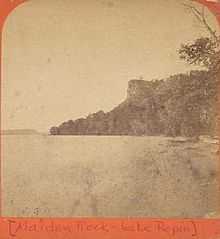Princess Winona

Princess Winona (Princess We-Noh-Nah) is the central Native American character in a "Lover's Leap" romantic legend set at Maiden Rock on the Wisconsin side of Lake Pepin in the United States. Princess Winona leaps to her death from Maiden Rock rather than marry a suitor she does not love.[1]
The legend
There are several variations of the story. Winona's father is sometimes said to be Chief Red Wing of what is now Red Wing, Minnesota or Chief Wabasha (Wapasha) of a village identified as Keoxa, now known as Winona, Minnesota. Rather than marry a suitor she does not love, Winona chooses to leap from the cliff of Maiden Rock to her death. It is much similar to the legend of Cherokee princess Noccalula of Noccalula Falls Park in Gadsden, Alabama. Who the suitor is depends on the version of the tale. Some versions featured him as a French trapper; others say he is a Native American of another tribe.
In the traditional Dakota language, "Winona" is not a personal name, but a general term for a first-born child of any class distinction who happens to be female.
The concept of the central figure as a "princess" is in keeping with a European-American stereotype about Native American "princesses." In fact, the Sioux do not have an equivalent title for "princess" in any of the major dialects.[2]
Today "Winona" has become regularly used as a personal and place name throughout the United States.
The location

Winona, Minnesota is associated with the legend because it was formerly the site of Keoxa. The character of "Princess Winona" has entered popular regional culture. It has been featured in Watkins Incorporated advertising, a prominent statue (currently located by Huff St. between 5th and 6th Streets after being located in other city parks), a stained glass window, and elsewhere.
While the Upper Mississippi version of the legend is the most prominent, there are other sites with variations of this legend.
Mark Twain in Life on the Mississippi wrote: "There are fifty Lover's Leaps along the Mississippi from whose summit disappointed Indian girls have jumped." Other locations with a similar legend include Winona Falls in Pennsylvania, Camden County, Missouri and Cameron Park in Waco, Texas.
The Wenonah Fountain is located in downtown Winona, Minnesota at Windom Park, named after the Politician William Windom,[3] and was donated by William J. Landon in memory of his wife Ida Cone Landon in 1900.[3]
References
Notes
- ↑ "Traveling the Great River Road: follow the scenic circle through charming towns on the Mississippi shores of Minnesota and Wisconsin - Tour Of The Month", Business Network, accessed 9 Dec 2008
- ↑ Porter, Cynthia (1 February 2009). "Homecoming to explore roles of American Indian women". Winona Post (Winona, MN). Retrieved 14 November 2010.
- ↑ 3.0 3.1 "Windom Park". Visit Winona. 2010. Retrieved 14 November 2010.
Bibliography
- The journals of Zebulon Pike (1805) contain a brief mention of the legend; this is the earliest instance of it being recorded and mentioned by a European American.
- Legends of the Northwest, by Hanford Lennox Gordon (1836–1920), contains a lengthy poetic version of this story, entitled "Winona, a Legend of the Dakotas"
- Mark Twain describes a version of the legend in Life on the Mississippi
- Emilio DeGrazia, a professor of Winona State University, and a published author, wrote a short play about her life entitled Winona: A Romantic Tragedy. This play has been performed on stage and published in book form.
External links
- Mary Henderson Eastman, Dahcotah, or, Life and Legends of the Sioux Around Fort Snelling (1849), (chapter "The Maiden's Rock, or, Wenona's Leap")